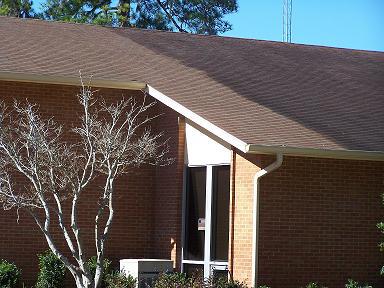Low Pressure Chemical Roof Cleaning
Roof Cleaning on a planned schedule should be part of your overall exterior maintenance plan. If your roof is black or has black streaks on it don’t assume you need a new roof. Low pressure roof cleaning can remove the unsightly black stains or streaks on asphalt shingles. These stains are actually a type of algae called Gloeocapsa Magma. In the Southeastern US, this algae type thrives because of the humid and warm climate. It typically appears on the North or Northeast slopes of the roof where shade is more prevalent and moisture accumulates. Over time, rain spreads the algae down the roof, causing the black streaks. As the algae breaks down the shingles, the granules that protect the shingle are loosened and fall off. This causes the roof to deteriorate and lessens the roofs ability to reflect heat rays. If left untreated, the algae will reduce the life of your roof, diminish your home’s curb appeal, and increase your home cooling cost.
This roof algae can be killed and removed to restore your roofs appearance. But the correct chemicals and low pressure are a must, so that you do not damage the roof.
The Asphalt Roofing Manufacturers Association Technical Bulletin regarding Algae Discoloration of Roofs further explains the algae and proper chemicals to use in cleaning the roof.
Care should be given to personal safety and avoiding damage to other parts of your home and surrounding landscaping. Use normal precautions for handling bleach. Observe a common sense approach regarding ladders and working on the roof. It is best not to work on the roof, if possible. Rinse any overspray to other parts of your home not being treated, especially windows, cars, etc. Many contractors cover the landscaping with plastic prior to rinsing the roof. Other contractors will water the landscaping prior to, during, and after the roof is being rinsed. If gutters are present, be sure to capture or direct the runoff away from landscaping.
The chemical solution should be sprayed on with a pump-up sprayer and carefully rinsed off using regular water hose pressure. What the technical bulletin does not address is dwell time. Dwell time is the length of time you should allow the solution to remain on the roof.
The good news is the solution should not harm the roof if it is allowed to dry. Twenty minutes should be plenty of dwell time prior to rinsing the solution off. However, other contractors don’t rinse it at all. In their situation, the home owner understands the roof will not look “like new” until rain has rinsed the algae away. The thought behind this method is it will maintain the roof for a longer period of time because the rain will not completely remove the solution allowing it to continue to kill the algae.
